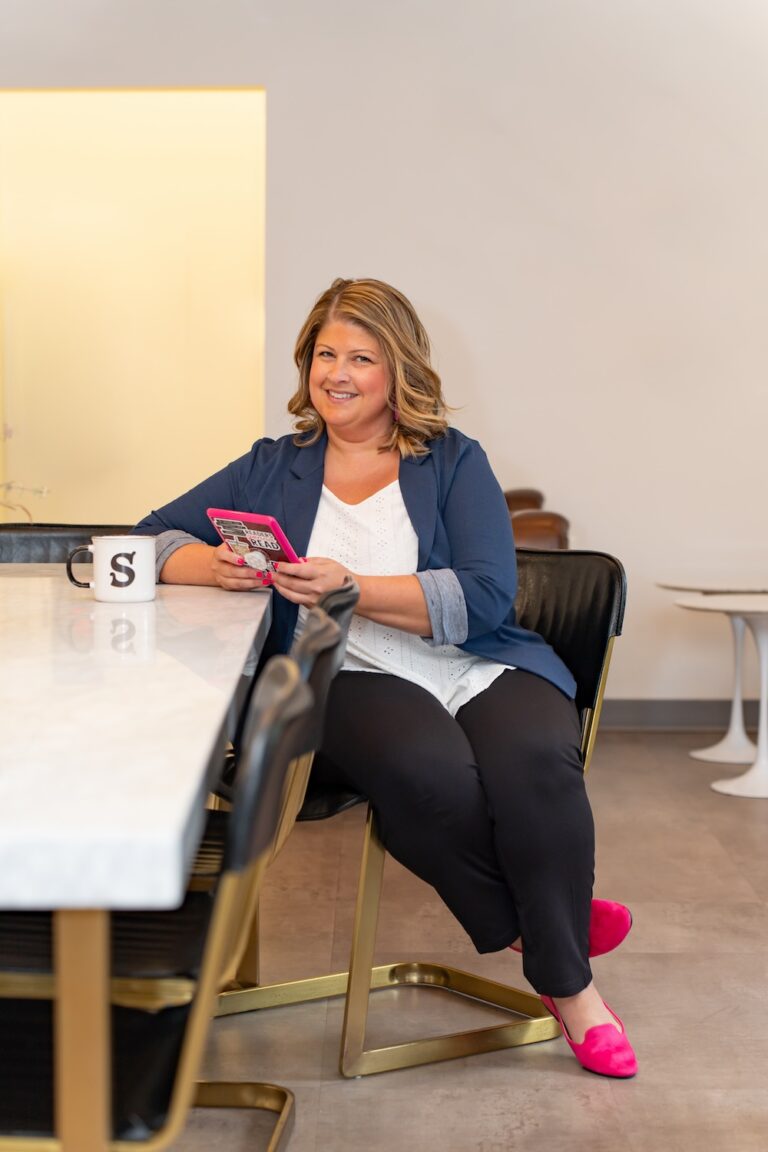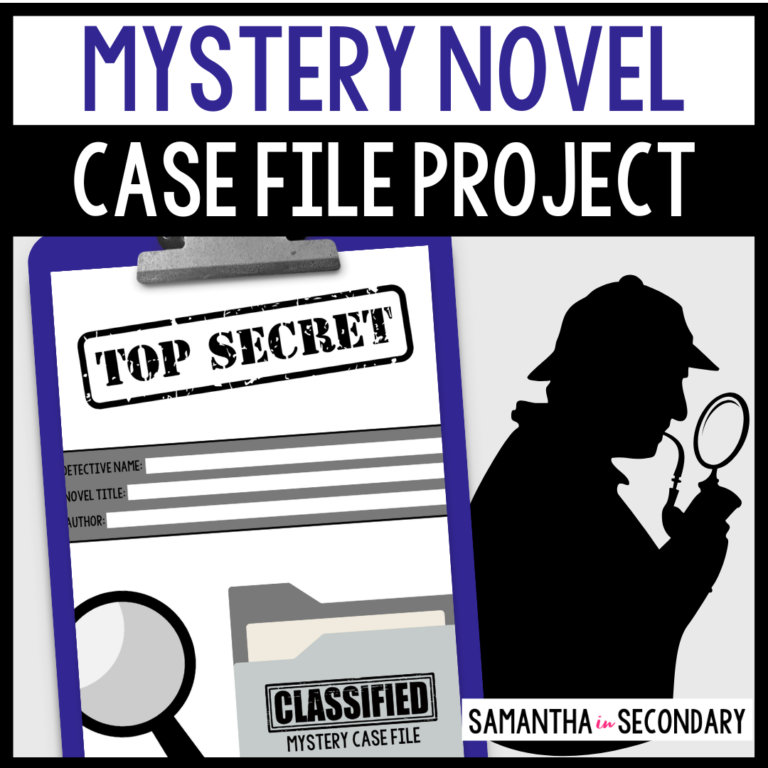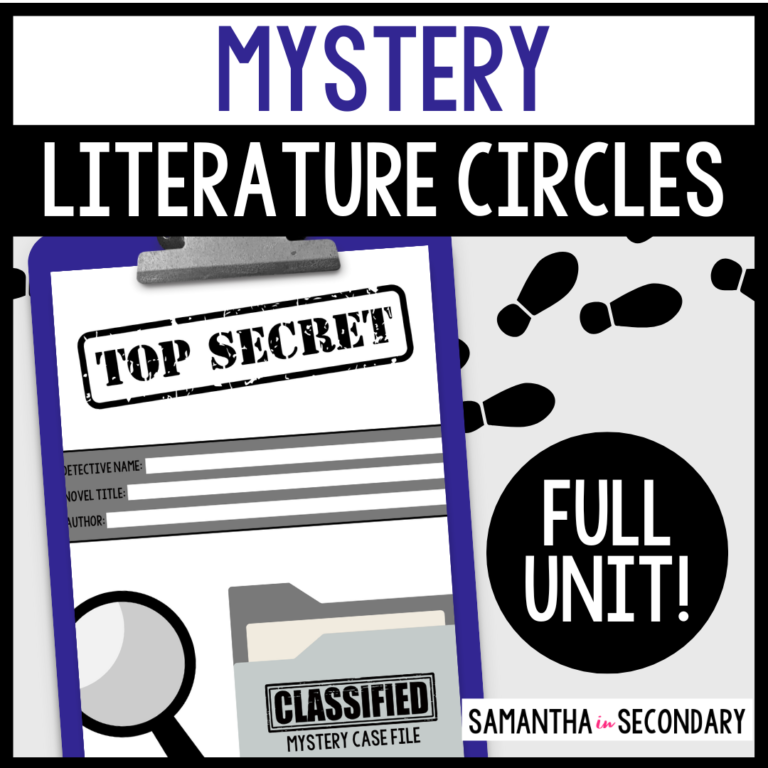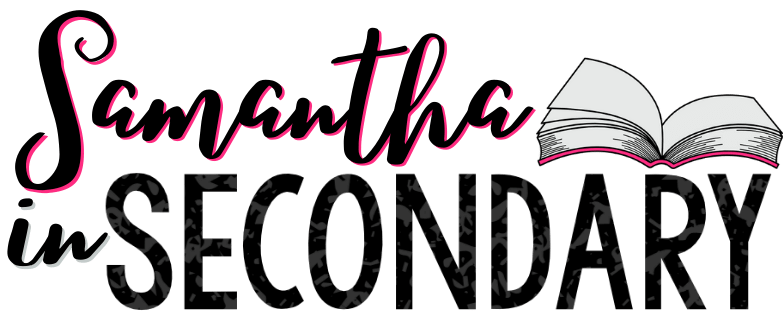Maybe you’d love to try literature circles in your class, but you just don’t know where to start. Or maybe you’ve tried them before, but they didn’t go over well. Today I’m going to walk you through my framework for planning and executing a flawless literature circle in the mystery genre. Get ready, joyful readers, it’s going to be a good one!
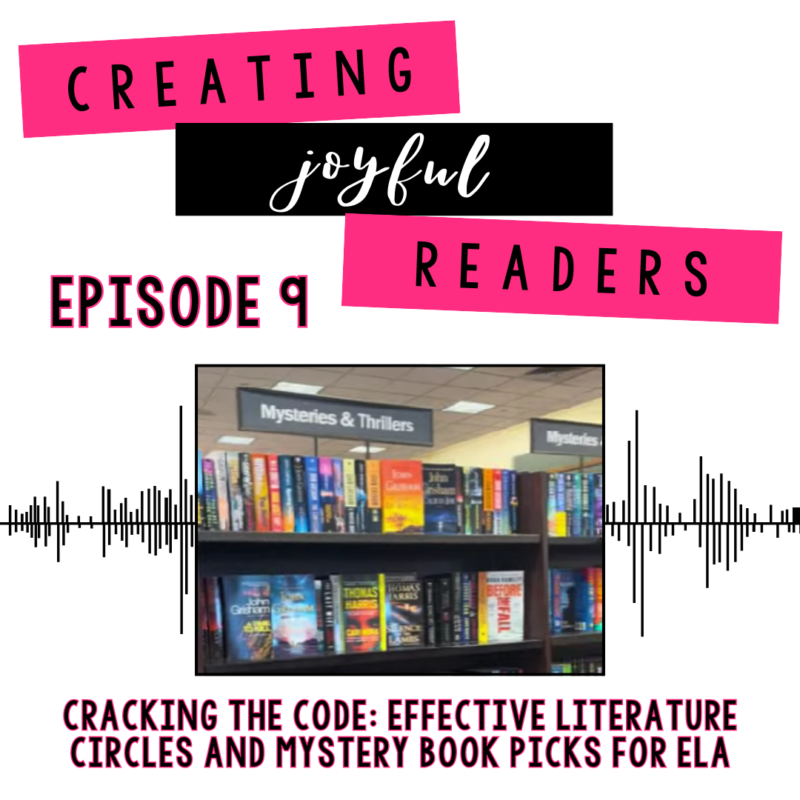
Links & Resources:
Some links referenced here are affiliate links. Supporting the podcast through these links comes at no additional cost to you.
Resources Mentioned:
–> Try the Mystery Case File activity in your classroom
–> Grab a copy of my full mystery unit
–> Shop for your modern day literacy classroom HERE:
https://www.teacherspayteachers.com/store/samantha-in-secondary
–> For tips, book recommendations, and connection with other educators follow along on INSTAGRAM:
https://www.instagram.com/samanthainsecondary/
–> Shop my favorite YA books HERE:
Prefer to read? Open the transcript here.
Samantha 00:00
Maybe you’d love to try literature circles in your class, but you just don’t know where to start. Or maybe you’ve tried them before, but they didn’t go very well. Today, I’m going to walk you through my framework for planning and executing a flawless literature circle in the mystery genre. Get ready, joyful readers, it’s going to be a good one.
Samantha 00:21
Welcome to Creating Joyful Readers, a podcast dedicated to empowering secondary educators with the tools, strategies, and inspiration to cultivate a lifelong love of reading in their students. I’m your host, Samantha. Tune in each week as we explore the transformative power of independent reading. Delve into the latest research on literacy, dissect projects that will help your students showcase what they’ve learned in a unique way, and share curated recommendations of young adult novels that will captivate and engage your learners join in as we embark on a journey to create joyful, lifelong readers one book at a time.
Samantha 00:58
Before we jump into some mystery specific ideas for your literature circles, let’s just review a little bit of vocabulary to make sure we’re on the same page. I often use the terms literature circle and choice reading unit interchangeably. Then I call the specific discussion that happens within the unit a literature circle discussion. I know there are plenty of terms that you can use in place of those, like book clubs, for instance, or maybe even reader’s workshop, but just for sake of clarity, I want to establish common vocabulary so it’s clear what I’m referring to, even if that isn’t what you or your school specifically calls it. Today we’ll discuss how to structure literature circles specifically for the mystery genre, along with a few recommended books you can use. As I’ve said before, I don’t believe that unit planning is one size fits all, and I think you can have multiple ways to frame a unit. I like to align everything to a specific genre to start. But maybe you’d like to use a driving question, a clear cut topic, or you pick your standards first. None of these are inherently wrong. Decide how you’d like to frame your unit and begin there. In a previous episode, I discussed that plot is one literary element that very easily aligns with this genre. So I would choose a driving question and standards that focus on plot. My focus standard for this unit is RL 5, analyze how an author’s choices concerning how to structure a text, order events within it and manipulate time create such effects as mystery, tension or surprise. Here are a few driving question options, what elements of plot structure are emphasized in mysteries? Why is this necessary for the genre? How do authors build plot, use red herrings, and incorporate elements of different genres in mysteries to produce interesting and fresh stories? What are the different types subgenres of mysteries? Next I choose my learning tasks and a form of summative assessment. I’ll often choose the summative assessment first and work backwards. For this unit, I have a mystery case file project that I absolutely love. It helps students dive into any novel in an engaging, unique way. I’ll talk more about this specifically in the next episode. But if you want to see it now, you could head to my shop, Samantha in Secondary on teachers pay teachers and search mystery case file. Before you run the full unit, I always take a moment to pause and teach students about the hallmarks of the genre. I love using genre based units because I think students really grasp how they work. Libraries and bookstores are typically genrefied. Students can usually name a television show they like, and we can discuss the key elements of why they like it. It almost always ties into something genre specific. Once a student finds a genre they love, they will quickly be on the path to becoming a joyful reader, and it’s a beautiful thing to witness. When I’m ready to kick off the unit, I always run an activity to hook the student. For this unit, I love to use a mystery specific book tasting. Last time I ran this, my media specialist and I set the room up to look like something out of a crime scene with caution tape, magnifying glasses and related props. The students got really into it. We actually even ran a mini mystery within the book tasting and had students find clues inside the books. Once students pick their books, we’re ready to go. There are two ways you can run this unit. You can use it along with an anchor text, which we discussed in the last episode, number eight. In this case, students would read a little bit of their choice reading book each day and work on anchor activities during class. I like to do daily reading at the beginning of the class period, but you can play around with the timing and see what works best for your students. I know some people even like to do it at the end. I liked it at the beginning because it set the tone for class and helped me take care of all the housekeeping that happens when students first enter the door. This method also works if you have a required curriculum you have to use but you want to incorporate choice reading. Alternatively, you can give students back to back reading days and finish the unit much more quickly depending on how fast year students read. I always create literature circle discussion guides as soon as we get started. This would be a guide to help students dissect their novels so they’re better prepared to join discussion later. I found that with students who are really honing their skills participating in academic discussions, the guide was essential for helping them articulate their ideas clearly the guide should include. Basic information about the novel, a space to note key passages, an opportunity to generate questions before participating in the discussion, and a place to reflect on their key takeaways for students who need extra scaffolding, I’d also include a list of discussion starters and general questions to help generate discussion. A few in the mystery genre might be which elements of mystery were present in your novel? Which subgenre of mystery would your book fall under? Which element of the plot do you believe had the biggest impact on the overall story? You can see that it doesn’t matter that students are all reading different books, because they’re all going to be able to respond to the questions from their own novels depending on how long it takes your students to read. Refer to episode number six, where I discuss how to keep them all on the same pace. You can schedule your literature circle discussion when they finish, it should take roughly one class period for the discussion. But if you have students who haven’t fully developed these skills, it might be even less. Leave plenty of time for students to rate their own performance. It’s a powerful practice that will help them improve each time you run a discussion, if you want to use the same rubric I use in my own classroom, head to the show notes for a link. Last I made sure to give my students a summative assessment that was both unique and engaging to show what they know for mystery, I love having them do a case file project, and I’ll discuss that more in depth in the next episode. I’ll also give you some ideas for supplemental materials you can use to reinforce both the skills and the genre elements, so definitely tune in next week for that. So to recap, we teach the students about the genre, we pass out a literature circle guide, we read the book, discuss as a class, and then complete a project that’s the gist of the structure. I love to play with supplemental materials and also connect the choice reading with my anchor text, because that was usually my preferred delivery method. There is so much flexibility with this type of teaching that you can really experiment to figure out what works best for you and your students.
Samantha 06:53
So you might be wondering, how do you figure out which books to use within your choice reading unit? I will say that I’m usually very flexible with literature circles. The anchor text is where I focus my effort to make sure that students are getting a solid example that is both educational and interesting. With literature circles, students should have the flexibility to develop the skill of choosing the book on their own. And trust me when I tell you they’re going to miss. I usually do allow students to switch books if they aren’t interested, but with a cutoff date, I want them to be excited about reading, but I also need them to finish their assignments. So I try to find a sweet spot date to allow them to test out a book, but if they’re really struggling, I try not to make them continue. We don’t want to create miserable readers. So finding a book the student is interested in is key. When we’re doing our book sampling activities, I try to give as many recommendations as possible. This includes book talks and book trailers, or any way I can get students to see what’s inside of the book. For the sake of time, I’m not going to do a deep dive here, just a couple of suggestions, but I’m going to give you some recommendations as well as a resource to find more. Whichever anchor text I chose from Episode Eight, I’d make sure to recommend the other two that I didn’t use, as long as they’re both age and content appropriate for your specific students. If you don’t already have my guide for 100 YA books to add to your classroom library, pause this episode and grab it now. You can find it at www.samanthainsecondary.com/books there is a mystery section included. Some texts may overlap, but you should be able to find some more good recommendations there. In no particular order, here are 10 suggestions for your literature circles in mystery. Number one, A Good Girl’s Guide to Murder by Holly Jackson. This is for grades nine and up about 400 pages and at the Lexile level of 700. A determined high school student reopens a local cold case for her senior project uncovering secrets that put her in danger. This is also a Netflix show as well, and remains one of my favorite YA mystery series of all time. Number two, The Girls I’ve Been by Tess Sharp. Grades nine and up, 368 pages, 670 Lexile. A former con artist must use her skills to survive when she and her friends are taken hostage during a bank robbery. This is also eventually going to be a TV show starring Millie Bobby Brown. And the second book is even better than the first one. Number three, One of Us is Lying by Karen M McManus. Grades nine and up, 416 pages, 730 lexile. 4 high school students become suspects in a murder investigation after a fellow classmate dies during detention. This is part of a three book series, and I believe, is also a television show. Number four, Monday’s Not Coming by Tiffany D Jackson. Grades eight and up, 448 pages, 620 Lexile. A teen girl’s relentless search for her missing best friend exposes painful truths in their community. Really anything by Tiffany D Jackson is going to be a hit. Number five, Sadie, by Courtney Summers. Grades 10 and up, 320, pages, 750 Lexile. A young woman sets out to avenge her sister’s murder, while a true crime podcast follows her horror journey. This is excellent on audio, if you are allowing your students to use audio as well. And I highly recommend that. Number six Stalking Jack the Ripper by Kerri Maniscalco. Grades 10 and up, 464 pages, 860 Lexile. In Victorian London, a girl secretly studies forensic medicine and hunts the notorious Jack the Ripper. This is a great choice for any of your teenagers who absolutely love the romance genre as well. It straddles quite a few genres, and I just love it. Number seven, The Agathas, by Kathleen Glasgow and Liz Lawson. Grades nine and up, 416, pages, 660 Lexile. Two high school girls team up to solve the mystery of their classmate’s disappearance. Inspired by Agatha Christie novels, this one also has several follow ups. Number eight, The Inheritance Games, by Jennifer Lynn Barnes. Grade 7 and up, 640 Lexile, 384 pages. A teen inherits a billionaire’s fortune, but must solve a series of puzzles and survive dangerous family rivalries to claim it. Number nine, Promise Boys by Nick Brooks. Grade 10 and up, 304 pages, no. Lexile available. Three boys from an inner city charter school band together to clear their names when they’re framed for their principal’s murder. Again, another one that is excellent on audio, and it’s full cast, so you get lots of different voices, and it’s great. Number 10, Their Vicious Games by Joelle Wellington. Grades nine and up, 432 pages, no Lexile available. A black teen competes in a deadly competition among the elite to secure a college scholarship, but soon realizes the stakes are higher than she imagined.
Samantha 10:37
Again, just a reminder, make sure to vet all books for your specific students, but hopefully this list should give you a good place to start.
Samantha 11:44
Alright, so today, we walked through the structure of a mystery literature circle and discussed some titles that would be great for your unit. Next week, we’ll chat about supplementary materials that you can use to make your unit more exciting and also work on different skills. Until then, happy reading.
Samantha 11:59
Thanks for tuning in to creating joyful readers. I hope you found inspiration and practical strategies to ignite a passion for reading in your students. Remember every book we introduce and every reading experience we foster can transform lives and help students become lifelong readers. Follow me on social media at Samantha in Secondary for more tips book recommendations and to connect with a community of educators dedicated to making reading a joyful journey, until next time happy reading.
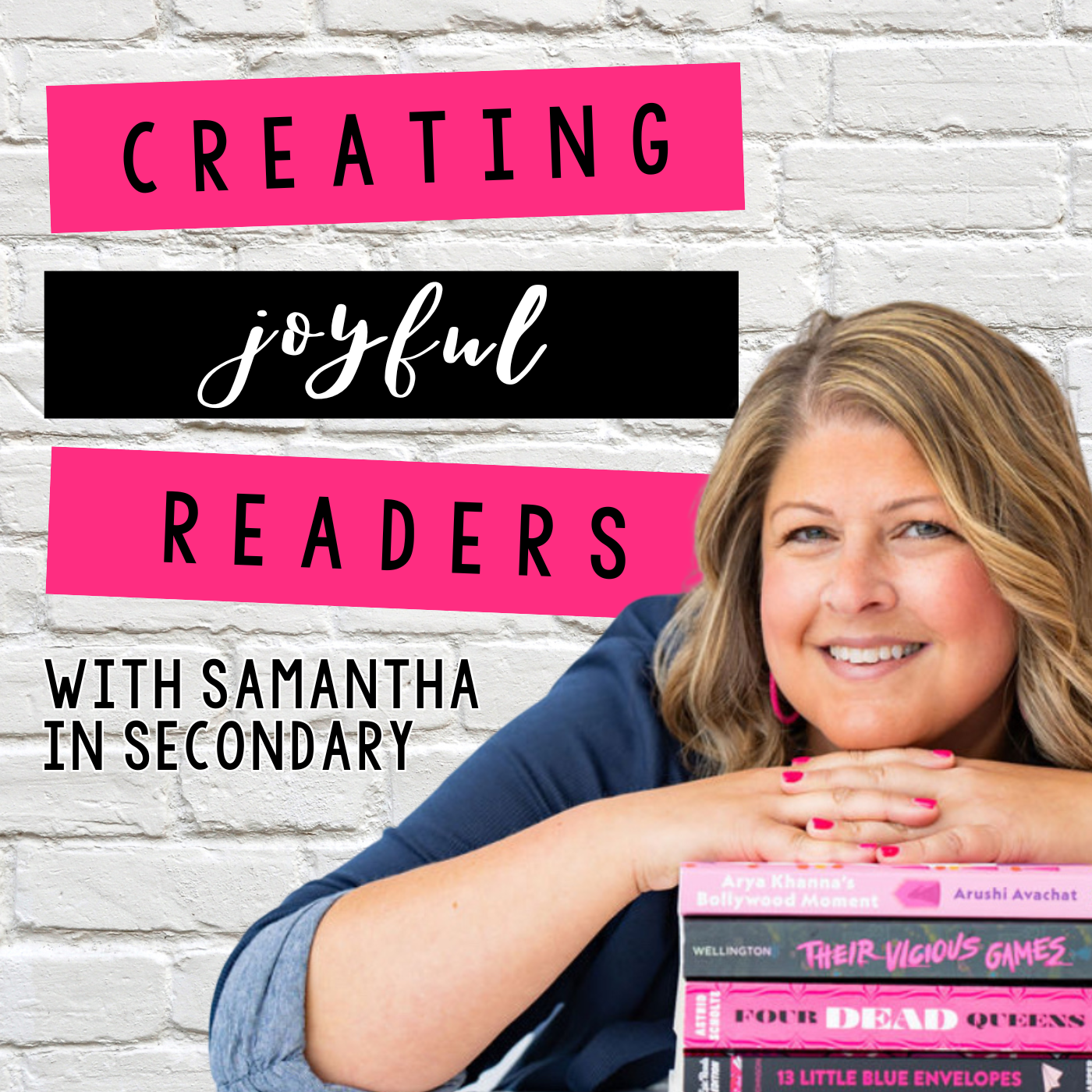
The Podcast
Creating Joyful Readers
It is possible to inspire a lifelong love of reading in secondary ELA students and that’s what the Creating Joyful Readers podcast is all about.
Join us every Monday as we dive into the latest in literacy research, talk about fresh Young Adult book recommendations, and chat fresh strategies to motivate your secondary students to love reading again.
Meet Your Host
Welcome! I’m Samantha, a veteran educator with 15 years of classroom experience and a Masters in Education, dedicated to transforming how students experience reading. My passion lies in empowering ELA teachers to foster joyful, independent readers in their classrooms.
Through this podcast, I’ll share the latest literacy research, practical tips, creative project ideas, and fresh book recommendations, all designed to help you ignite a love for reading in your students and make reading a delightful adventure, not a chore.
